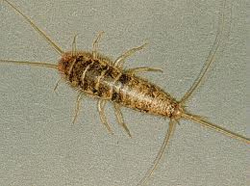

Silverfish and firebrats eat a wide variety of foods, including glue, wallpaper paste, bookbindings, paper, photographs,starch in

clothing, cotton, linen, rayon fabrics, wheat flour, cereals, dried meats, leather and even dead insects. Silverfish often live in damp, cool places such as basements and laundry rooms. Sometimes, they are found in a bathtub, sink or washbasin, unable to climb out.
Free Estimate
Firebrats live in hot, humid places such as attics in summer and near furnaces, fireplaces and heat pipes in winter.
Identification
Silverfish and firebrats have flat, elongated bodies 1/3 to 3/4 inch long and broad near the head, tapering toward the rear-somewhat "carrot" shaped. These fragile, wingless insects are covered with scales and have two long, slender antennae at the head and three long, antennae-like appendages at the rear. These three appendages, one directed straight back and the other two curving outward, plus the two antennae, are nearly as long as the body. Sometimes these insects are known as "bristletails."
The silverfish adult is about 1/2 inch long with a uniform silvery or pearl-gray color, whereas the four-lined silverfish is about 5/8 inch long and the back displays four dark lines the length of the body. The gray silverfish is about 3/4 inch long and uniform light to dark gray.
The firebrat is about 1/2 inch long, greyish and mottled with spots and bands of dark scales. Young resemble the adults except they are smaller. Eggs are whitish, oval and about 1/32 inch long.

Life Cycle and Habits
Silverfish and firebrats are active at night and hide during the day. When objects are moved where they are hiding, they dart out and seek new hiding places. The silverfish lives and develops in damp, cool places (prefers 75 to 95 percent relative humidity), often in the basement, bathroom and kitchen. Large numbers may be found in new buildings where the walls are still damp from plaster and green lumber.
The firebrat is quick moving and lives in dark places above 90 degrees F such as around ovens, furnaces, boiler rooms and fireplaces or insulation around hot water and heat pipes. These insects follow pipelines from the basement to rooms on lower floors, living in bookcases, around closet shelves, behind baseboards and behind window or door frames. They are hardy and can live without food for many months. Bristletails prefer to eat vegetable matter. Indoors, they will feed on rolled oats, dried beef, flour, starch, paper and paper sizing (which contains starch), gum and cereals. Outdoors, they can be found under rocks, bark and leaf mold, and in ant, termite, bird and animal nests.
Silverfish females may lie over 100 eggs during a lifetime. Eggs are laid singly or two to three at a time in small groups, hatching in three to six weeks. Young silverfish and firebrats resemble adults except being smaller, white and take on the adult color in four to six weeks. Adults may live two to eight years. Firebrats lay about 50 eggs at one time in several batches. Eggs hatch in about two weeks under ideal conditions.
Silverfish and firebrats, depending on the species, may reach maturity in three to twenty-four months. These insects normally hitchhike into the home in food, furniture, old books, papers and old starched clothing. Unlike other insects, they continue to molt after becoming adults. Forty-one molts have been recorded for one firebrat. Populations do not build up fast. A large infestation in the house usually indicates a longtime infestation.
Prevention
Sanitation is important but not entirely effective in reducing populations because insects often reside between wall partitions, in insulation materials, in books and papers, among book shelves and in other protected places. However, be sure to remove old stacks of newspapers, magazines, papers, books and fabrics plus foodstuffs spilled and stored for long periods of time. Often reducing available water and lowering the home's relative humidity with dehumidifiers and fans is helpful. Repair leaking plumbing and eliminate moisture around laundry areas. Lighting a dark, sheltered area may force these insects to move to new sites where they can be controlled more easily. Once the infestation has been eliminated, sanitation will help prevent reinfestation.
If you think you may have Silverfish or Firebrats on your property, contact Cain Pest Control for a free consultation or for more information about Silverfish Control in Toronto and the GTA.
